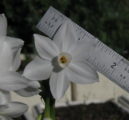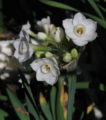Different paperwhites flower here in Canberra from about April to September. Flowering time is influenced by both rainfall and temperature.
A couple more paperwhite N. broussonetii seedlings have flowered here and these too have, at best, only slight fertility. The autumn flowering N. broussonetii is quite distinct so I think we have to say that it really does merit its own section (Aurelia). The hybrids can look a little ragged but I quite like their 11b lobes/splits.
One of the first paperwhites here is a tall large variety grown from Bill Welch seed.
Here it is shown behind a stem of the greenish tazetta hybrid 12_01TX (Taztep x Virivest). Also in the foreground is one of my nicest paperwhites 03_01W.
N. panizzianus can be quite perfect, here flowering in August.
The small size of these flowers can be gauged in this picture of N. pachybolbus (top) N. panizzianus (left) and 10_06W (right). Whether any of these is miniature in all climates is moot. Pachybolbus, aside from its plant habit, could pass as miniature in Canberra but not in Perth Western Australia.
Numerous crosses have been made here between paperwhites and N. dubius. I have trouble distinguishing true hybrids from paperwhites either from flower appearance or pollen. Plant habit seems to be the most reliable indicator. 16_05W is probably a dubius hybrid.
My ‘late’ flowering paperwhites mostly come from hybrids between a Pearl type tazetta and N. pachybolbus. Just opening now is 14_11W.













Lawrence,
The greenish Taztep x Viriwest is a nice and very special seedling with one chromosome set of a standard daffodil and three sets of the species N. payraceus, N. tazetta and N. viridiflorus. I think it has many very good and interesting traits.
The crosses of N. papyraceus with N. dubius have , as you know, the same chromosome structure as N. tortifolius (two chromosome sets from N. assoanus and two from N. papyraceus). What about the twisted leafs and the vigor? For me it was impossible to grow N. tortifolius for a longer time. The crosses with standard daffodils needed a long time to flower and don’t grow well.
Theo
Thanks Theo
I’ve had another close look at the putative paperwhite dubius hybrids. I still can’t see an obvious difference in pollen except for one hybrid that has yellow rather than orange pollen. Their leaves are no more twisted than paperwhites. Some of them are much less vigorous.
Your remarks on tortifolius hybrids are interesting. I recall someone saying Hiawassee was not particularly vigorous. I have some poet x pachybolbus hybrids that are ok but not spectacular. There are hints that not only are paperwhites reluctant to form hybrids, the hybrids aren’t great when they do. Perhaps tortifolius is similar.
Taztep x Virivest was a very good cross with a great diversity of seedlings. Not surprisingly they are highly sterile. These ones are flowering right now.
I once crossed panizzianus with triandrus triandrus. The resulting hybrids were gorgeous with several florets per stem. I could not keep them and blamed triandrus for their weakness. Maybe I was wrong. In thinking about it I recall that hybrids such as Icicle are reported to be hard to keep also.